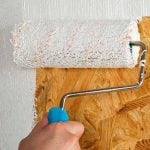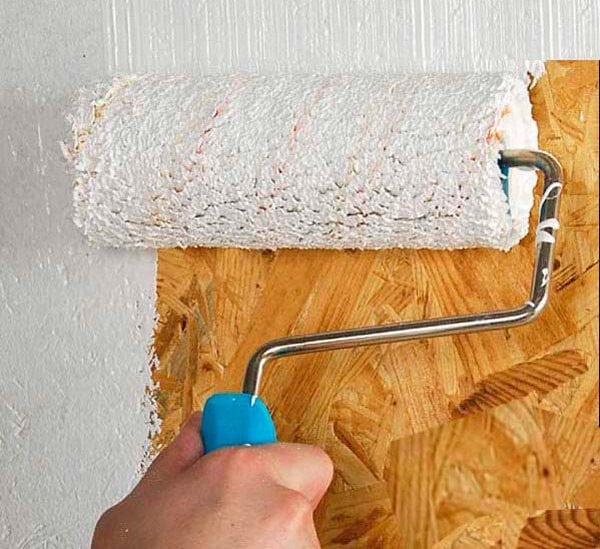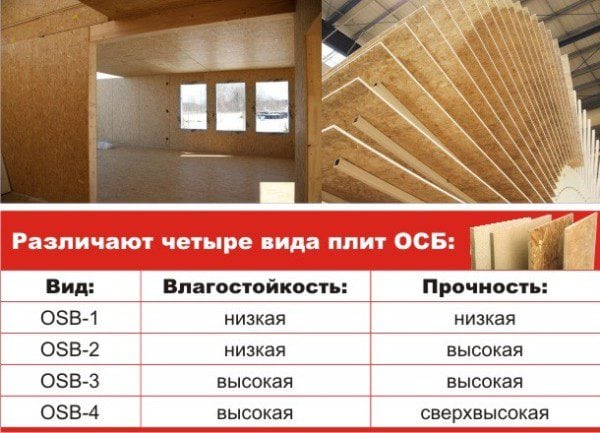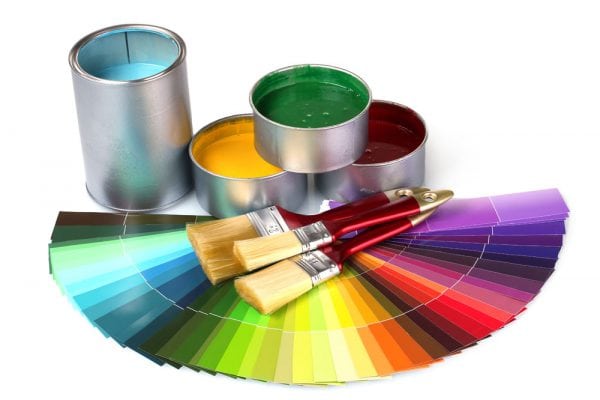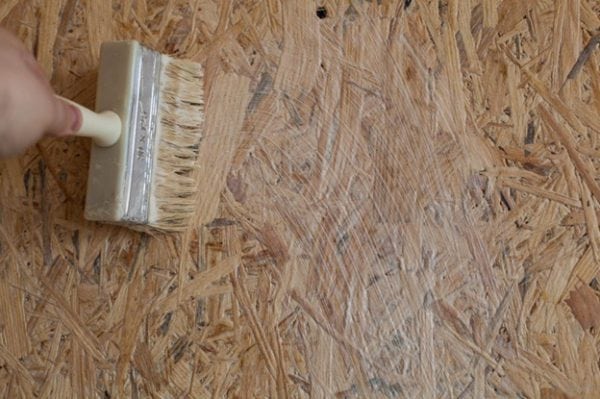Oriented Chipboard (OSB) is a composite material that is made from wood chips. Often there is a need for OSB staining, but the nature of the material is such that far from any paint is suitable for this operation. About how and with what to paint OSB outside, we will tell in this article.
Material Features
The main material for the manufacture of OSB is aspen, although other options are possible. The chips inside the approximately-particle boards are fastened together by means of resins, adhesives and polymeric substances.
According to the chemical composition (impregnating solutions, fillers, protectors, etc.) OSB are divided into 4 types:
- OSB-1 - used to decorate the interior of buildings operating in low humidity. Such plates are practically defenseless against high humidity.
- OSB-2 - suitable for rooms with a normal level of humidity.
- OSB-3 - used for decoration of premises in which there is a high background humidity or there is a possibility of direct wetting of the material. We also apply this type of plate for the decoration of facade surfaces.
- OSB-4 - refers to the most moisture-resistant type of plates. Especially often, this type of OSB is used for the construction of load-bearing structures at home.
For finishing work, the most common solution is to use OSBs of the second and third types. Therefore, the information offered in this article will be designed specifically for these categories of plates.
to contents ↑Advantages of staining OSB
Processing plates with paints and varnishes provides a number of advantages:
- Paint protects the material from the influence of negative environmental factors. First of all, we are talking about humidity.
- The paintwork allows you to hide the true and not the most attractive texture of the plate.
- Painting is a less labor-intensive and expensive way to finish OSB than facing with decorative panels.
to contents ↑Note! Most often, in order to maximize protection, the boards are varnished. This option also helps prevent pigment fading.
Paint selection
The correct selection of paint for OSB is the main issue that interests the masters. Below we list the characteristics of the main types of paints used for coloring plates:
- Organically soluble dyes are the best choice for OSB staining. The reason for this is the ideal interaction of the pigments of the coloring composition with resins and polymers located inside oriented particle boards. The combination of these components leads to excellent adhesion of the coating material to the wood.
- Oil paints can be considered a traditional, but somewhat outdated option. Such compositions are made from drying oil. Oil paints are highly viscous. The oil compositions also have disadvantages: shallow penetration into wood, toxicity, long drying time, short service life, the possibility of smudges even during operation, high cost.
- Alkyd enamels consist of a mixture of alkyd resins, vegetable oils and acids. This type of paint allows you to get a durable coating that is protected from moisture, ultraviolet radiation and temperature extremes. Alkyd paints and coatings are characterized by fairly rapid drying and relatively low toxicity.Another advantage of alkyd compounds: after their application, it is not necessary to varnish the surface, which reduces the cost of work. The disadvantages of alkyd solutions include fire hazard, instability to alkalis, pungent odor during drying. Alkyd enamel can be applied only on perfectly dry wood, as otherwise, coating may bubble.
- Acrylic water-dispersed solutions are also often used for staining OSB. The attractiveness of acrylic compositions is due to many of their advantages: environmental friendliness, ease of application, rich color palette, resistance to humidity, temperature changes and ultraviolet radiation. Also, thanks to water, such paints are fire resistant. However, the presence of water in the composition may cause swelling of the wood board.
- Latex aqueous emulsion solutions differ in many advantages: the highest elasticity, resistance to mechanical stress, moisture and household chemicals. Also, the latex base is environmentally friendly and durable. Latex paints do not emit unpleasant odors. The only significant drawback of latex formulations is their high cost.
- Impregnations based on tall and linseed oils (for example, “Valtti Color Satin” from the Finnish company “Tikkurila”) are often used to hide the natural texture. Glazing impregnations contribute to the formation on the surface of a matte or slightly glossy protective film.
- It is possible to stain OSB with electrically conductive paint (for example, “Zinga”). This paint contains metal, resulting in a very durable and protected coating. However, the surface before applying such a paintwork material needs serious preparation.
- If it is necessary to protect the boards in a special way from fire, it is recommended to use antipyretics specially designed for wood (for example, Wuprotek).
Stain preparation
The quality of staining largely depends on the correctness of the surface preparation.
Preparatory work is carried out according to the following algorithm:
- It is best to prepare the surface and apply paint to it even before installing the boards.
- We thoroughly polish the surface with sandpaper. This allows us to accomplish two tasks: mask the texture of the product and remove the protective layer, which does not allow the soil and paint to penetrate into the panel. Important note: OSB-3 slabs should be subjected to particularly careful grinding, since they are pre-applied with a lacquer-wax coating.
- The remaining irregularities, as well as the fastening points of the screws, are treated with putty. In the case of OSB, it is recommended to use compositions on an oil-glue basis.
- We also fill the seams between the panels with an oil-glue composition. However, most often the seams will still be visible under a layer of paint. Therefore, the question of whether to cover the seams remains at the discretion of the master. If necessary, you can mask the seams with decorative trims.
- When the putty dries, we clean the surface with sandpaper. The wood should be as even as possible.
- Next, primer the surface. The most common type of soil is water-based varnish (acrylic, polyurethane-acrylic). The varnish is diluted in a ratio of 1 to 10 and is applied to the panel.
- You can also treat wood with alkyd varnish. However, White Spirit will be used as a solvent in this case.
- Another option is adhesive primers (for example, Aqua Filler). Such primers very well isolate wood from a paint and varnish coat. This is especially useful if the OSB is made from oily wood. In this case, the adhesive primer will block the exit of oil to the surface.
Dyeing
Instructions for applying paint:
- First, paint with a brush around the perimeter of the panel. Moreover, we impose a thicker layer of paintwork on the edges, since the absorption in these places is the highest.
- We distribute the paint with a roller over the entire surface of the plate. The paint layer should not be thick. We carry out coloring in one direction.
- In the case of water-dispersion solutions, it is necessary to especially monitor the uniformity of the application of paint. The fact is that the plate after such paints inevitably swells, and it is necessary to ensure at least its uniform deformation.
- Dry the plates well. During the drying period, drafts and temperature differences are unacceptable in the room.
- We apply the second layer after the previous one has completely dried. Paint this time is applied perpendicular to the direction of the previous layer.
- If necessary, apply additional layers of paint material.
Staining OSB-plates is not the most difficult job, since this material is rarely seriously affected by the external environment, and therefore the requirements for the protective layer are not too strict. And, nevertheless, in order to achieve acceptable quality, it is necessary to choose the right material and adherence to a certain technology. The tips suggested in this article should come in handy for this wizard.

